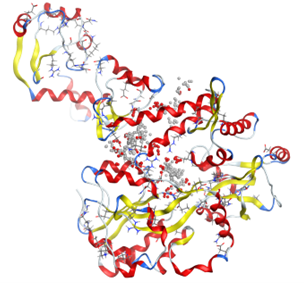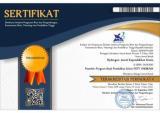
Chemical Composition Analysis of Citrus×limon (L) Osbeck Leaf Essential Oil and Its Activity as an Anti-Cervical Cancer Agent
Abstract
Cervical cancer is a life-threatening disease. The use of synthetic drugs for its treatment can have serious adverse effects on the body. Therefore, it is necessary to search for natural drugs that are safe for the body. One of the secondary metabolites contained in plants is essential oils (EO), EO are known to have activity as anti-cervical cancer. Genus Citrus is known for containing EO compounds, one of the species of the genus is Citrus×lemon (L) Osbeck. The purpose of this study is to identify the chemical components of the EO isolated from the leaves of C×limon and to evaluate its cytotoxic activity against cervical cancer. EO was isolated from C×limon leaves collected in Padang City, Indonesia using the hydrodistillation method. EO was then analyzed by GC-MS. To determine its cytotoxicity, BSLT was conducted, followed by molecular docking and MTT assays. The experiment yielded a yellow liquid with a density of 0,8684 g/mL and a yield of 0,181%. GC-MS analysis of the EO identified 56 chemical components, with the main compounds are (-)-β-pinene (7.32%), (-)-limonene (28.40%), geranial (5.54%), caryophyllene (5.22%). The EO showed high toxicity against Artemia salina L larvae, with an LC50 value of 3,697 µg/mL. Through molecular docking, it is known the (-)-limonene, geranial, (-)β-pinene and caryophyllene compounds as the main compounds in of EO are known to bind to form complexes with cervical cancer proteins (HPV18E6). MTT assay showed weak cytotoxic activity of EO against HeLa cells, with an IC50 of 218.9 µg/mL.
Keywords
Full Text:
PDFReferences
Alia, R., Mastutik, G., & Hoesin, F. (2016). Ekspresi Protein HPV16 E6/18 E6 dan Protein P53 pada Adenokarsinoma Serviks. Majalah Patologi Indonesia, 25(1).
Bernardini, S., Tiezzi, A., Laghezza Masci, V., & Ovidi, E. (2018). Natural products for human health: An historical overview of the drug discovery approaches. Natural Product Research, 32(16), 1926–1950.
Delnavazi, M.-R., Saiyarsarai, P., Jafari-Nodooshan, S., Khanavi, M., Tavakoli, S., Hadavinia, H., & Yassa, N. (2018). Cytotoxic flavonoids from the aerial parts of Stachys lavandulifolia Vahl. Pharmaceutical Sciences, 24(4), 332–339.
Ehiobu, J., Idamokoro, M., & Afolayan, A. (2021). Phytochemical content and antioxidant potential of leaf extracts of Citrus limon (L.) Osbeck collected in the Eastern Cape Province, South Africa. South African Journal of Botany, 141, 480–486.
Grace, M., Subramanian, A., & Samuel, T. (2020). Synergistic larvicidal action of Citrus limon (L.) Osbeck (Rutaceae) and Bacillus thuringiensis Berliner 1915 (Bacillaceae) against the dengue vector Aedes aegypti Linnaeus 1762 (Diptera: Culicidae). GSC Biological and Pharmaceutical Sciences, 10(1), 025–033.
Hadisiwi, P., & Arifin, H. S. (2022). Sosialisasi Literasi Kesehatan Tentang Pencegahan Dan Penanggulangan Kanker Serviks Bagi Remaja Di Kab. Bandung Barat. Dharmakarya: Jurnal Aplikasi Ipteks Untuk Masyarakat, 11(2), 152–158.
Hamidi, M. R., Jovanova, B., & Panovska, T. K. (2014). Toxicological evaluation of the plant products using Brine Shrimp (Artemia salina L.) model. Macedonian Pharmaceutical Bulletin, 60(1).
Hüsnü Can Bașer, K., & Buchbauer, G. (2015). Handbook of essential oils: Science, technology, and applications. Handbook of Essential Oils: Science, Technology, and Applications., Ed. 2.
Khan, S., Sahar, A., Tariq, T., Sameen, A., & Tariq, F. (2023). Essential oils in plants: Plant physiology, the chemical composition of the oil, and natural variation of the oils (chemotaxonomy and environmental effects, etc.). In Essential Oils (pp. 1–36). Elsevier.
Lee, Y. T., Tan, Y. J., & Oon, C. E. (2018). Molecular targeted therapy: Treating cancer with specificity. European Journal of Pharmacology, 834, 188–196.
Liu, K. H., Zhu, Q., Zhang, J. J., Xu, J. F., & Wang, X. C. (2012). Chemical composition and biological activities of the essential oil of Mentha spicata Lamiaceae. Advanced Materials Research, 524, 2269–2272.
Liu, X., Yang, X., Chen, F., & Chen, D. (2017). Combined application of doxorubicin and naringin enhances the antitumor efficiency and attenuates the toxicity of doxorubicin in HeLa cervical cancer cells. International Journal of Clinical and Experimental Pathology, 10(7), 7303.
Mayasari, U., & Laoli, M. T. (2018). Karakterisasi Simplisia Dan Skrining Fitokimia Daun Jeruk Lemon (Citrus limon (L.) Burm.f.). KLOROFIL: Jurnal Ilmu Biologi dan Terapan, 2(1), 7. https://doi.org/10.30821/kfl:jibt.v2i1.1802
Nath, S., Tamuli, K. J., Saikia, S., Narzary, B., Gogoi, B., Bordoloi, M., Neipihoi, Dutta, D., Sahoo, R. K., & Das, A. (2021). Essential oil from the leaves of Elsholtzia communis (Collett & Hemsl.) Diels from North East India: Studies on chemical profiling, antimicrobial, cytotoxic and ACE inhibitory activities. Flavour and Fragrance Journal, 36(6), 626–636.
Nguyen, V.-S., Li, W., Li, Y., & Wang, Q. (2017). Synthesis of citrus polymethoxyflavonoids and their antiproliferative activities on Hela cells. Medicinal Chemistry Research, 26, 1585–1592.
Ningdyah, A. W., Alimuddin, A. H., & Jayuska, A. (2015). Uji toksisitas dengan metode BSLT (Brine Shrimp Lethality Test) terhadap hasil fraksinasi ekstrak kulit buah tampoi (Baccaurea macrocarpa). Jurnal Kimia Khatulistiwa, 4(1).
Nsangou, M. F., Happi, E. N., Fannang, S. V., Atangana, A. F., Waffo, A. F. K., Wansi, J. D., Isyaka, S. M., Sadgrove, N., Sewald, N., & Langat, M. K. (2021). Chemical composition and synergistic antimicrobial effects of a vegetatively propagated cameroonian lemon, citrus x limon (l.) osbeck. ACS Food Science & Technology, 1(3), 354–361.
Plants of the World Online. (2023). https://powo.science.kew.org/
Prakash, V. (2018). Terpenoids as cytotoxic compounds: A perspective. Pharmacognosy Reviews, 12(24), 166–176.
Ramírez, D., & Caballero, J. (2018). Is it reliable to take the molecular docking top scoring position as the best solution without considering available structural data? Molecules, 23(5), 1038.
Riaz, M., Qadir, R., Tahir Akhtar, M., Misbah Ur Rehman, M., Anwar, F., Eman, R., Fayyaz Ur Rehman, M., & Safwan Akram, M. (2023). Chemical Characterization, Antioxidant, Antimicrobial, Cytotoxicity and in Silico Studies of Hexane Extract and Essential Oils from Citrus limon Leaves. Chemistry & Biodiversity, 20(1). https://doi.org/10.1002/cbdv.202200537
Said, A., El Gendy, M., Raoof, G. A., Omer, E., Fouad, R., Abd EL-Kader, A., & Weinfeld, M. (2019). Cytotoxic activity and volatile components of peel oil of Citrus volkameriana. South African Journal of Botany, 127, 201–207.
Sajjadi, S. E., Ghanadian, M., Haghighi, M., & Mouhebat, L. (2015). Cytotoxic effect of Cousinia verbascifolia Bunge against OVCAR-3 and HT-29 cancer cells. Journal of HerbMed Pharmacology, 4(1), 15–19.
Sharifi-Rad, J., Sureda, A., Tenore, G. C., Daglia, M., Sharifi-Rad, M., Valussi, M., Tundis, R., Sharifi-Rad, M., Loizzo, M. R., & Ademiluyi, A. O. (2017). Biological activities of essential oils: From plant chemoecology to traditional healing systems. Molecules, 22(1), 70.
Suryati, S., Aziz, E. D., Efdi, M., Wahyuni, F. S., & Hefni, D. (2021). Analysis of the essential oil from Lantana camara leaves and its cytotoxic potential against T-47D breast cancer cells. Jurnal Riset Kimia, 12(1), 1–9.
SwissADME. (2024). http://www.swissadme.ch/index.php#
Thuy, B. T. P., My, T. T. A., Hai, N. T. T., Hieu, L. T., Hoa, T. T., Thi Phuong Loan, H., Triet, N. T., Anh, T. T. V., Quy, P. T., & Tat, P. V. (2020). Investigation into SARS-CoV-2 resistance of compounds in garlic essential oil. ACS Omega, 5(14), 8312–8320.
Tripathi, A., & Misra, K. (2017). Molecular docking: A structure-based drug designing approach. JSM Chem, 5(2), 1042–1047.
Ulia, R. V., & Santoni, A. (2023). Cytotoxic Potential of Essential Oil Isolated from Clibadium Surinamese L Leaves Against T47D Breast and HeLa Cervical Cancer Cells. Molekul, 18(2), 289–299.
WHO. (2020). Global Cancer Observator [World Health Organization].
DOI: https://doi.org/10.33394/hjkk.v12i1.10772
Refbacks
- There are currently no refbacks.

This work is licensed under a Creative Commons Attribution-ShareAlike 4.0 International License.





